Assisi is often associated with spirituality, pilgrimages, and the life of St. Francis. Yet, this medieval town 30 minutes from Perugia is still very much alive, a place where tourists of all kinds fall for its UNESCO sites, quintessential Italian piazzas, and a casual food and wine scene that unfolds around relaxed, tiny trattorias with simple wooden furnishings.
Just a couple of hours from Rome, it’s an ideal day trip or weekend getaway. Discover our 10 insider tips and find the best things to do in Assisi, Italy, like a local!

The best things to do in Assisi, Italy
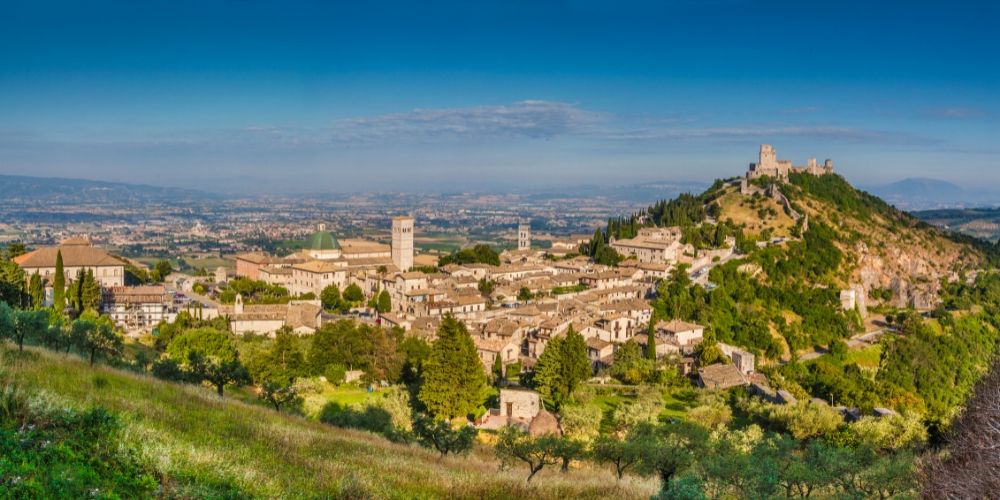
Beyond the Basilica of St. Francis, Assisi has several tricks up its sleeve. A surprising number of monuments, silent hermitages in the woods, Piazzas where the rhythm of life hasn’t changed despite the crowds, and curious art installations in the countryside are some of them.
Events are scheduled every month, but even if your visit does not line up with one, there is always something interesting to see or do.
In 2025, the Jubilee has brought thousands of pilgrims to Assisi, where many come for a spiritual retreat. Still, Assisi is not just for faith.
There are adventurous walking itineraries, hidden gems to visit nearby, and a culinary scene that ranges from rustic trattorias to Michelin Guide restaurants. It is a place worth visiting at least once. Want to learn more? Here are some of the best things to do in Assisi like a local.
Listen to the podcast version of the article with the voice of Monna Lisa & Leonardo
10. Things to do in Assisi, Italy. Visiting the Basilica
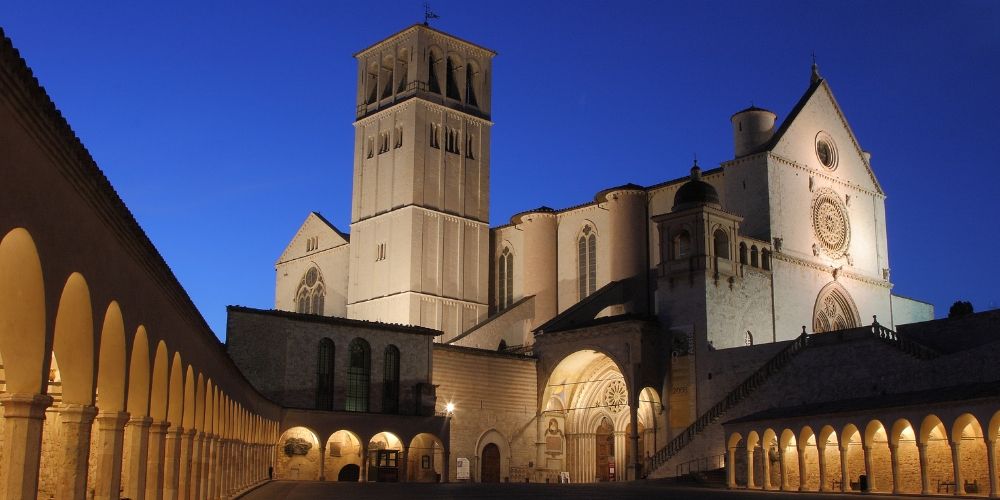
As one of the world’s most famous landmarks, the Basilica of St. Francis is not exactly a local secret. This UNESCO World Heritage site draws millions of visitors and pilgrims every year, but far from being a simple museum, it remains a vital place of worship for the local community, with daily services that remain an integral part of Assisi’s spiritual life.
Step inside to see incredible art in both the Upper and Lower Basilicas, including Giotto’s famous frescoes. No visit is complete without the Museo del Tesoro and its rare manuscripts, paintings, liturgical objects, and musical instruments from the 16th and 17th centuries. Entry is free, but donations help support the site.
Good to know: On busy days, visitors with disabilities can request a complimentary shuttle that drops them directly at the Basilica entrance. To arrange the service, call +39 075 8138680.
Now that you’ve explored Assisi’s most iconic sight, it’s time to continue your journey. Keep following our Assisi travel guide as we uncover the next insider tip.
Book Assisi day trip from Rome9. What’s the best time to visit Assisi like a local
The good news for travellers is that there is always something happening in town (and even if not, the Assisi attractions alone make your trip worthwhile).
One of the best times to visit Assisi is during Calendimaggio. For four days, the medieval spirit takes over: Parte de Sopra and Parte de Sotto, the two old rival districts, battle it out with music, theatre, and pageantry. Costumes flood the streets, drums echo down the alleys, and taverns dish up recipes pulled straight from the Middle Ages. The festival runs from the first Wednesday to Saturday after May 1.
In late August, the Palio di San Rufino fills the squares with spectacular crossbow contests. In September, Palio del Cupolone turns back Assisi’s clocks to the 1800s, complete with period costumes, traditional games, and old crafts brought back to life.
On October 4, the whole town celebrates St. Francis, and at Christmas Assisi lights up with festive markets and some of the most enchanting living nativity scenes in Italy.
8. Adding a hidden gem to your Assisi travel guide
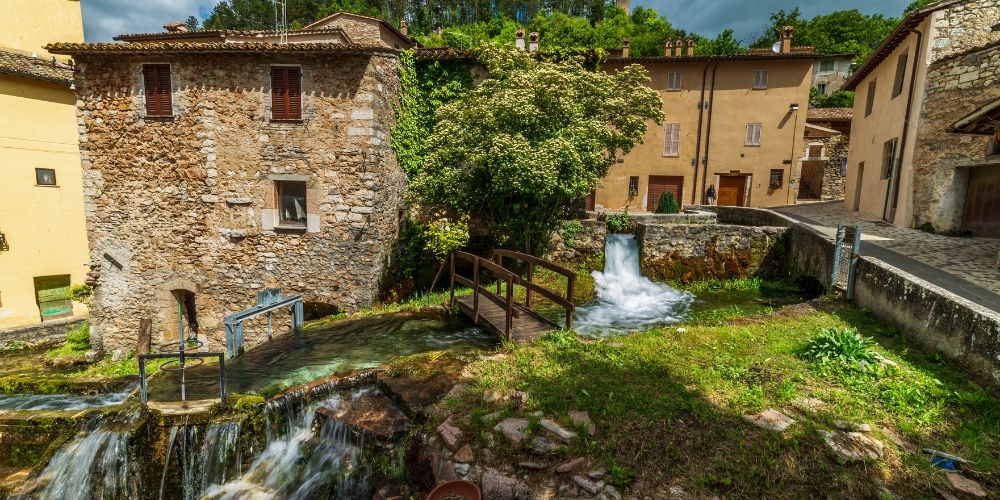
Rasiglia is a a tiny village often close to Assisi called the “Venice of Umbria” because of its clear streams weaving through stone houses and gardens. About 40 minutes by car, it makes a rewarding half-day trip.
The village, once a centre for wool production powered by water mills, has been beautifully restored. Today, visitors can stroll across the bridges, listen to the gentle murmur of the springs, and even visit the world’s tiniest chocolate museum!
Rasiglia represents the kind of destination Italians love for their weekend "gite": authentic, slightly off the radar, and easy to reach, too.
If you are planning to visit Assisi, consider a detour to Rasiglia for a taste of rural tranquillity. Learn more in our article dedicated to this Umbria hidden gem.
7. Finding the best restaurants in Assisi

Assisi’s food scene is pure Umbria: simple, seasonal, and full of character. Osterie and family-run restaurants (some Michelin-approved) serve up classics like torta al testo, a flatbread cooked on a hot stone and stuffed with whatever you like, or a plate of strangozzi pasta tossed with the famous black truffle.
Bakeries and pastry shops add a sweeter note to your trip. Try the rustic pane di San Francesco, the raisin- and nut-studded pancaciato, or rocciata, a spiral pastry of apples, walnuts, cocoa, and spice (if it looks familiar, you’re right: it’s the Umbria cousin of the better-known strudel).
Medieval-style mostaccioli and almond pastry baci di Assisi are the perfect gift for your special one (if you don’t finish them first).
Pair everything with a glass of local Grechetto or bold Montefalco Sagrantino, and you’ll taste Assisi’s tradition at its most genuine.
6. Eat, Sip, Hunt in Assisi, Italy
Assisi has flavours that stay with you long after the trip. The town sits in the Assisi–Spoleto olive belt, where extra-virgin olive oil has earned prized DOP status. Tasting it straight from the press, when it’s green-gold and has that special peppery bite, is something to try when in town, especially in the small family mills scattered across the hills.
Next stop: the wonders along the wine route Strada dei Vini del Cantico. Cellars here produce DOC Assisi wines: crisp Grechetto, bold reds, elegant riserva wines. Guided tastings are also an opportunity to learn stories about Mount Subasio’s land and people.
Then there’s truffle hunting, an experience that doesn’t always make it into an Assisi travel guid. Some hunters even let you join the search! With trained dogs, you head into the woods for black or scorzone truffles.
For food lovers, these experiences are as essential to Assisi as the Basilica itself.
5. Walking itineraries in Monte Subasio Park
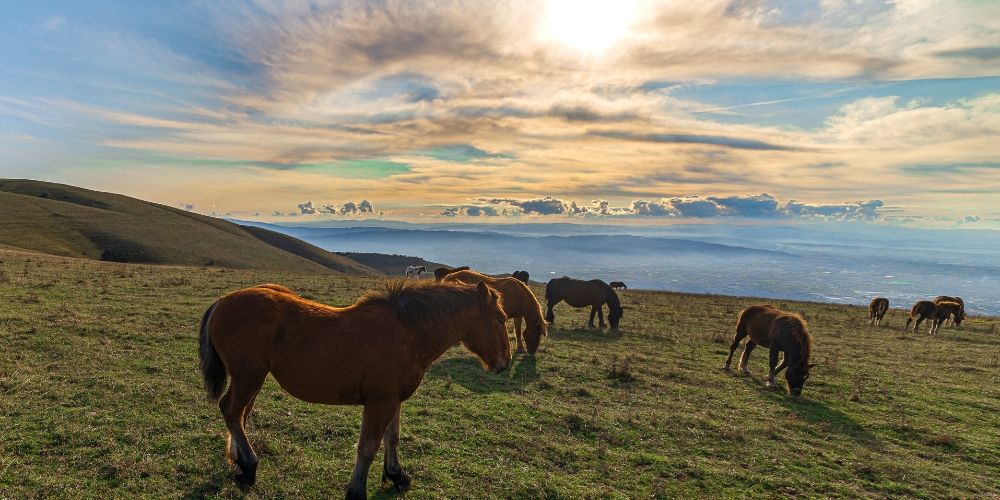
Monte Subasio Regional Park begins right at Assisi’s doorstep, a patchwork of oak woods, limestone valleys, and silvery olive groves.
Slipping on hiking shoes is the easiest way to extend your visit beyond churches and piazzas and into landscapes that once shaped Francis’s solitude. Out on the trails, the pace slows: broad views open over the Umbrian valley, paths cut through meadows and hamlets, and birdsong replaces city noise.
There’s a route for every mood. The Anello dei Mortari is an 11-kilometre loop through karst rock and pastures. The longer Assisi–Eremo delle Carceri–Sassopiano hike (around five hours) follows paths once walked by Franciscan friars. For something shorter, the shaded Forra del Marchetto is a shaded gorge walk of just over an hour.
For more things to do in Assisi and park tours ideas, visit the official tourist page of Assisi.
4. Visiting a hermitage in the forest
Just 4 km from Assisi’s centre, on the wooded slopes of Monte Subasio, the Eremo delle Carceri feels like a world apart. At 800 metres above sea level, this hermitage has long been a retreat for silence and prayer. In Francis’s time, it was only a small chapel where he and his companions withdrew from the city.
By the 14th century, the Franciscans had taken charge, building the first stone cells around Santa Maria. Later, St Bernardino of Siena expanded the complex into the place we see today.
Head up here for a snapshot of the very beginnings of Franciscan devotion. From the convent, a stone staircase winds through a beech wood to St. Francis’s cave, where visitors can still see his rough stone bed and the tiny cell where he prayed. The path continues outside, past other caves once used by his followers.
3. Drinking a coffee in Piazza del Comune
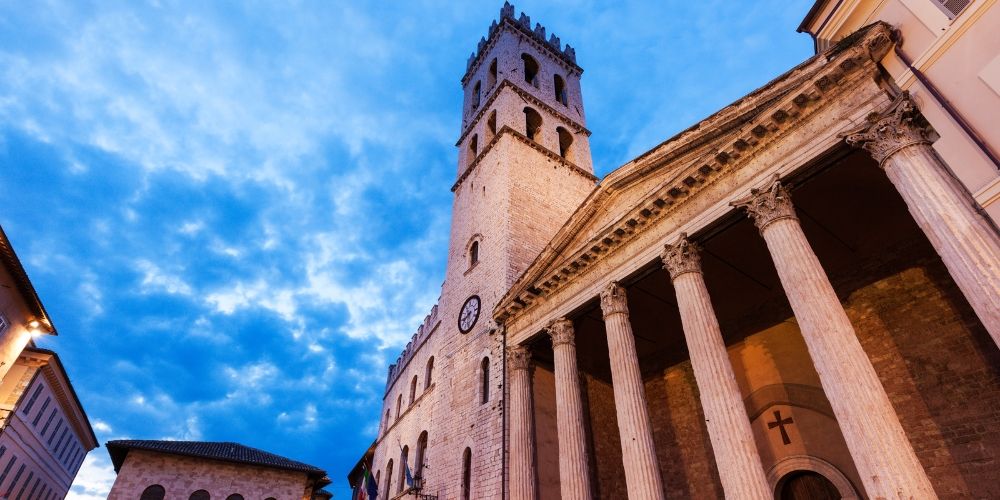
Piazza del Comune is the place where locals meet for coffee, trade gossip, or simply watch the day go by. With no cars allowed, it’s perfect for a slow stroll or a mid-morning break between visits. Order an espresso, sit back, and the square becomes a stage.
The scene is framed by the Temple of Minerva, a Roman jewel later turned into a church, and by the medieval Palazzo del Capitano del Popolo with its proud Torre del Popolo. Look closely at the base of the tower: a stone plaque still shows the measurements once used for bricks and tiles in medieval times.
Beneath all this bustle lies another Assisi: the Roman Forum, hidden just beneath the cobblestones and waiting for anyone curious enough to descend. Would you go down? Entry is on Via Portica, through the Romanesque crypt of the former church of San Niccolò, a hidden gem among Assisi attractions.
2. Reaching Assisi’s best viewpoint
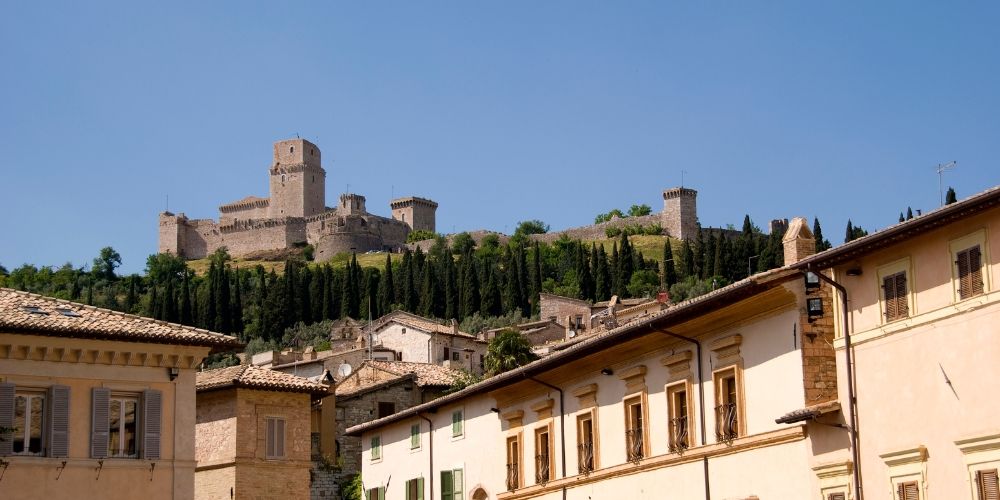
Perched above the town, Rocca Maggiore looks like it was lifted straight from a medieval postcard. The fortress first appears in records in 1173, when troops loyal to Frederick Barbarossa occupied Assisi.
Destroyed in a popular revolt, it rose again in 1362 under Cardinal Egidio Albornoz, who gave it the imposing form we see today. Later additions (the tall Mastio and the polygonal watchtower) completed its skyline.
From the battlements, the views of Assisi’s red-tiled roofs, rolling hills, and olive groves are just what it takes for a few epic photos.
To reach the fortress, start from Piazza Matteotti and follow Via della Rocca uphill; the walk takes about 10–15 minutes, winding through charming alleys and gardens before opening onto the castle gates.
Inside, restored halls and historic emblems tell the story of its centuries-long role in Papal and civic life. Join a guided tour or pick up an audioguide to get the most out of your visit. Rocca Maggiore is a top choice to add to the list of things to do in Assisi Italy.
Visit Assisi top attractions1. Entering a fairy wood
Bosco di San Francesco is a green oasis located behind the Basilica of St. Francis in Assisi. Restored by the Italian Environmental Fund, the 64-hectare woodland weaves meadows, olive groves, and winding trails.
From the piazzale, a path invites visitors into a green area comprising two distinct sections: Selva di San Francesco and Bosco di San Francesco. Campana della Pace, a bell representing the unity of the world’s major religions, is placed at the starting point.
As you wander in, keep an eye out for statues celebrating peace and human dignity. Bridges, ruins, and ancient paths appear along the way: Ponte dei Galli, which legend says Charlemagne crossed, the remains of a former 13th-century hospital, and the small Romanesque church of Santa Croce.
The trail along the Tescio River open onto clearings with sweeping views of Rocca Maggiore.
The climax of the walk is called Terzo Paradiso (third paradise), Michelangelo Pistoletto’s installation of 121 olive trees in three interlocking circles, which embodies harmony between nature and humanity.
Visit Bosco di San FrancescoThings to do in Assisi like a local - FAQ
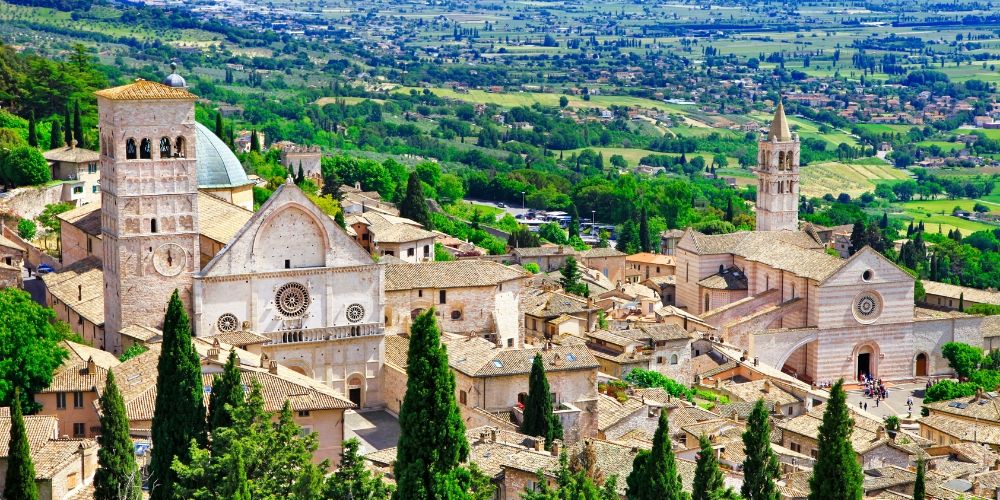
What is Assisi famous for?
Assisi is best known as the birthplace of St Francis, one of the most beloved saints in the world. The Basilica of St. Francis Assisi, a UNESCO World Heritage Site, attracts millions of visitors each year for its spiritual significance and Giotto’s frescoes. Furthermore, Assisi is famous for its medieval streets, panoramic views, traditional festivals, and lively food scene.
How do you get to Assisi from Rome or Florence?
An Assisi day trip from Rome is easy: trains run regularly from Roma Termini to Assisi (usually with a change in Foligno), taking about 2–2.5 hours. From Florence, trains take under 3 hours, typically with a change at Terontola-Cortona or Perugia. By car, park outside the historic center (ZTL); main paid lots are Mojano (with escalators to the center), Porta Nuova (escalator when in service), Matteotti, and Giovanni Paolo II (near the Basilica of St. Francis). Guided tours or private transfers are convenient, especially to combine Assisi with nearby Umbrian towns.
What are the must-see attractions in Assisi?
The Basilica of St. Francis Assisi and other religious sites like Basilica di santa Maria degli Angeli, Basilica di Santa Chiara, Chiesa di san Damiano, Cattedrale di San Rufino; the medieval Rocca Maggiore; Eremo delle Carceri; Bosco di San Francesco; the Temple of Minerva; Torre del Popolo and Palazzo del Capitano del Popolo; Palazzo Vallemani.
Is Assisi worth a day trip?
A well-planned day trip gives you enough time to see the main Assisi attractions. However, staying overnight allows you to experience the town’s quieter side once the crowds leave — something every Assisi travel guide recommends.
About the author
Written on 05/10/2025


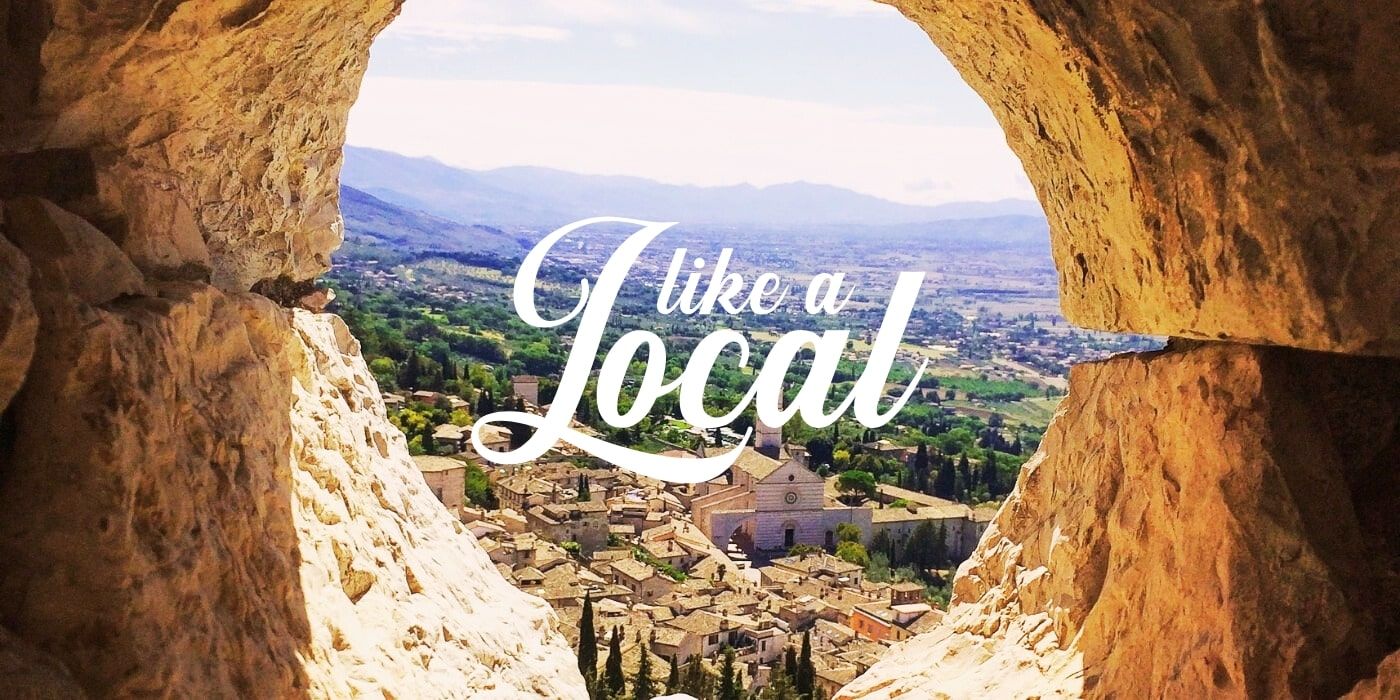

Lorena Calise
Insider tips for the best things to do in Assisi, Italy: attractions, walks, and local experiences you shouldn't skip.